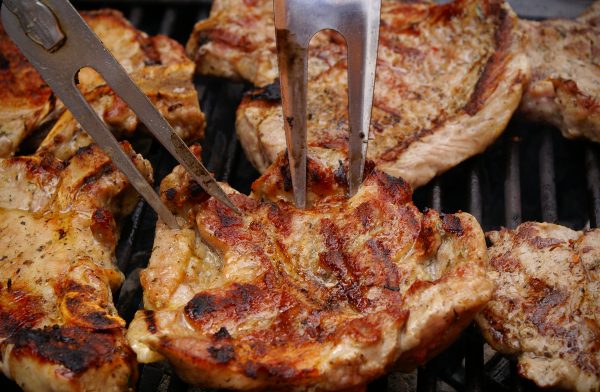Beef Consumption Trends in United States
Posted by David Widmar on April 5, 2021

During the meridian of doubt nearly the pandemic and economic shutdown, the U.S. meat sector establish itself in the eye of several COVID-related disruptions.
On the demand side, consumers rushed to the grocery stores, initially emptying the shelves, while restaurant activeness slumped and summer BBQs were in limbo. Withal, the supply-side challenges proved to be even more challenging throughout the leap and summer.
With some of the uncertainty settling, this calendar week'southward mail steps dorsum to review U.Due south. meat consumption trends and the forecasts for 2020 and 2021.
U.South. Meat Consumption, 1970 – 2020
Throughout this post, we discuss per capita meat consumption. It is important to note the USDA reports these data as per capita meat disappearance. This measure is the balance of production, beginning and catastrophe inventories, import, and export data.
In other words, the USDA does not explicitly measure consumption simply offers a proxy measure that is substantially consumption. When discussing consumption, we are truly reporting the USDA's measure out of meat disappearances. Furthermore, a decrease (or increase) in consumption is not a change in demand.
Effigy 1 shows the per capita consumption of total red meat and poultry since 1970. Later peaking at almost 222 pounds in 2017, full meat consumption began to slump during the Dandy Recession and eventually hit a low of 202 pounds in 2014. Beginning in 2015, meat consumption trended college and is forecasted at 225 pounds in 2020. Looking ahead, total consumption is expected to slump slightly into 2021 (224.8 in 2021 compared to 225.1 in 2020).

Figure ane. Per Capita U.Southward. Full Carmine Meat and Poultry Consumption, 1970 – 2021f. Data Sources: USDA ERS and WASDE.
U.S. Beef Consumption – A Long Decline, With A Recent Upturn
Across the full consumption trends, information technology'south important to recognize each meat has its ain set of opportunities, challenges, and trends. Effigy two shows U.South. beefiness consumption, which has been a long story of decline.
In the 1970s and early on 1980s, per capita consumption was around eighty lbs. Consumption slipped but stayed around 65 pounds throughout the 1990s and early 2000s. After the Bang-up Recession, consumption slipped, once more, to a low of 54 pounds.
For 2020, consumption was more 58 pounds. On the 1 hand, the upturn since 2015 is significant and noteworthy. However, the reality is that beefiness consumption remains well beneath 65 pounds per capita, which was terminal observed in 2007.
For 2021, consumption is estimated to exist slightly lower than in 2020, down 0.4 pounds per capita yr over year.

Figure 2. Per Capita U.S. Beef Consumption, 1970 – 2021f. Information Sources: USDA ERS and WASDE.
U.S. Pork Consumption – Mostly Flat
Overall, pork consumption has been by and large flat at fifty pounds per capita over the last 50 years (Figure 3). At 52 pounds in 2020, forecasted consumption is expected to increase 0.v pounds in 2021. Pork consumption has not been in a higher place 52 pounds per capita since 1999. Furthermore, consumption is considerably above the 2011 lows of 45.7 pounds.

Figure 3. Per Capita U.S. Pork Consumption, 1970 – 2021f. Data Sources: USDA ERS and WASDE.
U.S. Poultry Consumption – A Dramatic Increase
The decades-long trend toward more poultry consumption is well known. At less than 50 pounds in the early 1970s, poultry consumption is forecasted at 113 pounds in 2021. Broadly speaking, the trend is dramatically different from failing per capita consumption in beefiness and stable consumption of pork.
In the 1970s, poultry accounted for less than 25% of the full U.Due south. meat consumption. Since 2014, however, poultry has accounted for a majority.

Figure 4. Per Capita U.S. Total Poultry Consumption, 1970 – 2018f. Data Sources: USDA ERS and WASDE.
Wrapping it Up – Meat Consumption After the Pandemic
Three principal observations are worth keeping in mind. First, U.Due south. consumption varies significantly depending on the type of meat. While full consumption is increasing, it has been largely driven by an increment in poultry consumption to offset the decline in beef and holding pattern for pork. Of course, these data don't reflect changes in overall consumer need or total consumption. In 1970, the U.S. had an estimated population of 205 million, compared to 331 meg in 2020.
2d, given all the turmoil and doubt in 2020, meat consumption has been fairly steady and looks to remain so in 2021. For all three categories, consumption in 2021 is currently forecasted to be within 0.ane pounds of 2019 levels. This was non the case during the Bully Recession when beefiness (-4.2 pounds per capita) and poultry (-five.ix pounds per capita) contracted sharply from 2007 to 2009. These forecasts will exist of import to monitor in the coming months.
Finally, i lesson to keep in mind from the Slap-up Recession is the duration and magnitude of adjustments. Thinking most the current reality, one must wonder if the impacts of COVID and 2020 will as well linger for years to come.
Click here to subscribe to AEI's Weekly Insights email and receive our complimentary, in-depth articles in your inbox every Mon morning.
Looking for more than? AEI Premium provides even more insights and content. It is too where you can challenge your thinking with the Ag Forecast Network (AFN) tool. Kickoff your run a risk-gratis trial here.
Source: https://aei.ag/2021/04/05/u-s-meat-consumption-trends-beef-pork-poultry-pandemic/